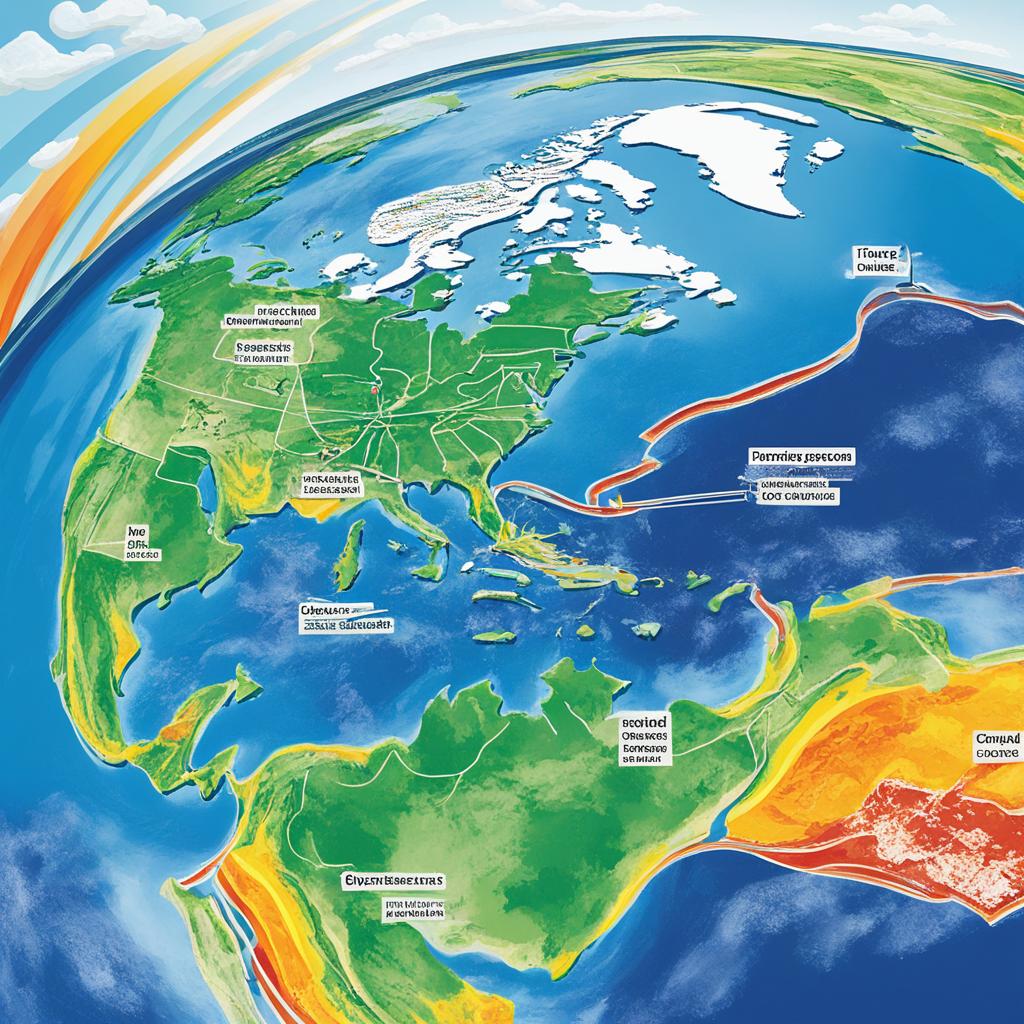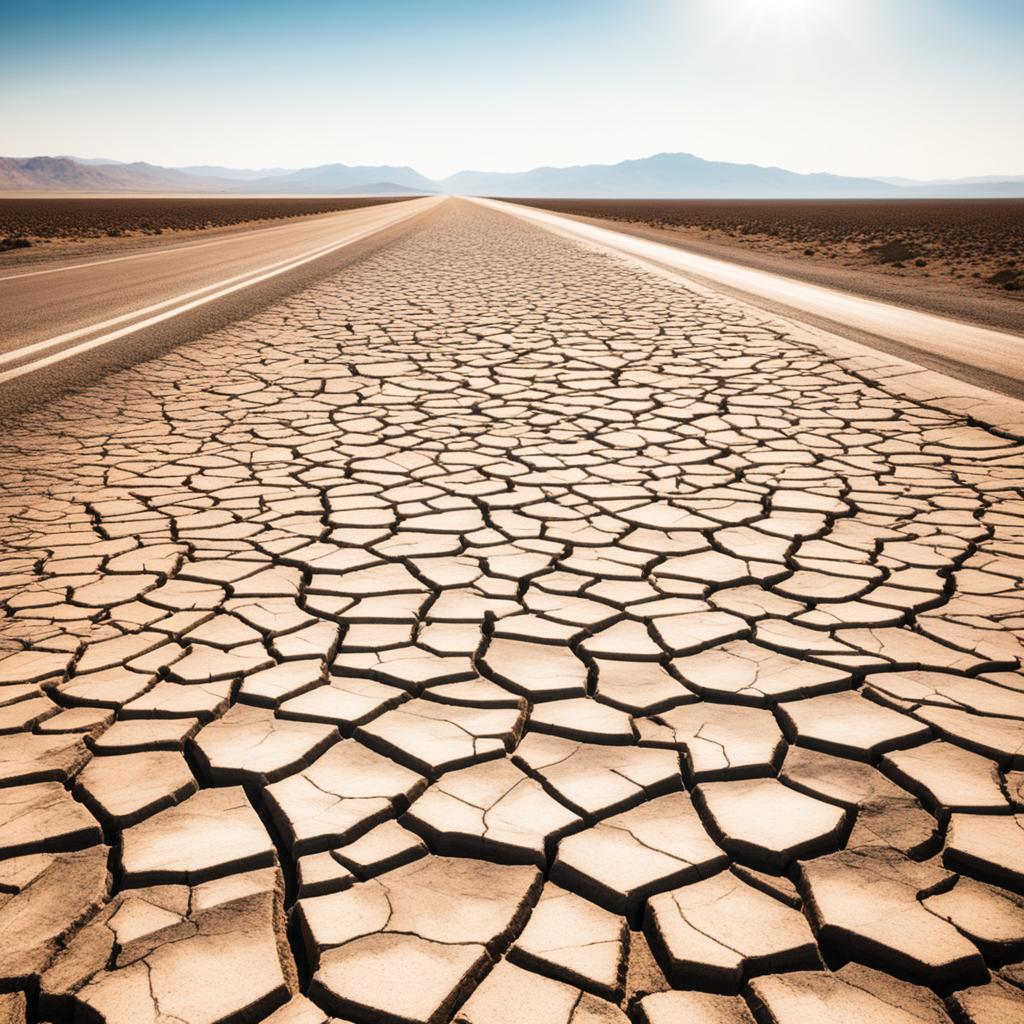In July 2022, England faced a heatwave like no other. Temperatures rose above 40°C at several weather stations. This broke old records and showed a big change from the usual weather. The heatwave warns us about big changes on our planet because of human-caused climate change.
Greenhouse gases like carbon dioxide are building up fast. They make a cover in the sky, keeping heat close to Earth. This makes our planet warmer, changing the weather, water cycle, and melting ice. These changes lead to more extreme weather events, like heavy hurricanes and strong heatwaves.
Climate change is transforming our world. Learning about the science of these extreme events is key to getting ready for and easing their impact on us. In this piece, we will look at new research and ideas. We’ll see how climate change is causing these changes. And we’ll find out how to become stronger in front of an unknown future.
Understanding Climate Change and Its Impact
Climate change comes mainly from human actions and the use of fossil fuels. This has caused a big jump in greenhouse gases and higher global temperatures. The Earth is getting warmer, changing how weather works, impacts the water cycle, and increases ice melt. These changes lead to more often and stronger extreme weather worldwide.
Greenhouse Gas Emissions and Rising Temperatures
Since the Industrial Revolution, our greenhouse gas emissions have shot up. This has steadily warmed the air and oceans. The average Earth surface temperature is now 1.2°C higher than in the late 1800s. The last decade was the hottest on record. Each of the last four decades was warmer than any time since 1850.
In 2020, the biggest seven emitters made half of the world’s greenhouse gases. Policies now suggest the Earth might get 3°C hotter by 2100. But, we must halve emissions by 2030 to prevent going over 1.5°C hotter. This cut would help avoid major climate impacts.
| Statistic | Value |
|---|---|
| Global temperature rise since the late 1800s | 1.2°C |
| Warmest decade on record | 2011-2020 |
| Projected temperature rise by the end of the century | 3°C |
| Emissions reduction needed by 2030 to limit warming to 1.5°C | 50% |
Over two-thirds of today’s proven reserves of fossil fuels need to be kept in the ground by 2050 to prevent catastrophic levels of climate change. Limiting global temperature rise to no more than 1.5°C would help avoid the worst climate impacts. Developed countries have agreed to give $100 billion a year to help developing countries with climate work.


As the planet faces climate change’s effects, understanding the causes is key. We need to know the science to make good plans to fight and deal with these issues.
Extreme Weather Attribution Studies
In the early 2000s, a field called climate science research started focusing on how humans affect extreme weather. This area is called “extreme weather attribution“. It connects climate change with real weather events. More than 400 peer-reviewed studies show that 71% of extreme weather events were worsened by human activity.
Attribution studies prove the link between climate change and extreme weather. The World Weather Attribution (WWA) found that human activity made floods in Europe much more likely. They also found that a heatwave in the Pacific Northwest was a rare event and was hotter because of climate change.
Studies also show that due to climate change, some extreme events are happening more often. For example, a study on tropical storms in 2020 found that human activity made storm rainfall and total rainfall worse.


Understanding climate science helps us see how events like extreme weather are linked to climate change. This knowledge is driving changes in climate policy and legal actions. It’s making countries and companies work towards reducing their impact on the planet.
Mapping the Evidence: Attribution Study Findings
In the last few years, scientists have learned a lot about the connection between climate change impacts and extreme weather events. Carbon Brief conducted a detailed analysis of every extreme weather attribution study so far. This research has illuminated the worldwide mapping of these key discoveries.
The study found that 71% of 504 extreme weather events were more likely or severe due to climate change caused by humans. This shows how much our actions affect the Earth’s weather and the rise in extreme events.
Trends and Patterns in Attribution Studies
The data highlights major trends from the attribution studies. For example, 93% of 152 extreme heat events were worsened by climate change. Also, 56% of 126 rainy or flood events, plus 68% of 81 droughts, were made more severe by us.
What’s more, the research in this area is growing, especially in reports like the ones from the Bulletin of the American Meteorological Society. This shows how committed scientists are to exploring the link between climate change and extreme weather.
| Extreme Weather Event | Percentage Linked to Climate Change |
|---|---|
| Extreme Heat | 93% |
| Rainfall or Flooding | 56% |
| Drought | 68% |
The results of these studies offer strong, data-driven insights into the global climate system’s vulnerability to our actions. As research expands, it’s getting clearer to policymakers, scientists, and the public that we need to act fast to tackle the climate change impacts.
Climate Science and Wildfires
Wildfires have always been a part of life in the western United States and Canada. But, with the region getting hotter and drier from climate change, they’re getting worse. In recent years, California has seen large, fierce wildfires. These are fueled by dry weather, high seasonal winds, and heat. In 2020, California saw its biggest fire season ever, burning over 4 million acres.
Scientific studies show the west has seen more big fires between 1984 and 2015, with numbers doubling. A single degree Celsius temperature rise could lead to a dramatic 600 percent increase in burned area each year in some forests. While people start over 80 percent of these fires, the trends clearly indicate a link to a warming climate.
The costs of these wildfires are also huge. In 2017 and 2018, NOAA said they cost the U.S. over $40 billion. The 2018 season in California was the worst ever, leading to the Forest Service spending over half its budget on suppression. Plus, the national cost to fight the fires in 2017 and 2018 was $5 billion combined.


The effects of climate change keep getting worse. The scientific community is striving to understand how wildfires and climate change are related. Groups like the Climate & Wildfire Institute are working hard to find solutions. They’re trying to connect scientific findings to public policy and decisions. Still, there’s a challenge with sharing and managing data among different groups. This makes it hard to fully use the available info for better policy and actions.
Heatwaves: A Growing Health Risk
As global temperatures get hotter, we see more extreme heat in many areas. This means more super hot days in more places. For example, in the past 50 years, Austin and Houston have seen a lot more days over 100°F and 95°F.
Scientists say this trend will keep going through the year 2100. This kind of heat makes us use more energy for cooling and makes life hard, especially for those who are already vulnerable.
Rising Temperatures and Their Impacts
Heatwaves can be dangerous. Heat-related deaths for people older than 65 increased a lot between 2000–2004 and 2017–2021.
Worldwide, almost half a million people die from the heat every year. A big part of these deaths is in Asia and Europe. The summer of 2022, over 60,000 people in Europe passed away from the heat.
People who live in cities, in poor conditions, or do hard physical work are at bigger risk. But, we can do things to prevent these deaths. Even things that are simple, easy, and not expensive can help save lives.


“Extreme heat is a leading cause of weather-related deaths in the U.S., averaging over 600 deaths annually from 1999-2009. Heat waves rank among the top 10 deadliest U.S. disasters since 1980.”
Since 1895, the U.S. has warmed by about 1.5°F, mostly since 1970. If we don’t stop polluting, it could get 5°F to 10°F hotter by 2100. This could make major cities like New York, Philadelphia, Chicago, and Boston much hotter, leading to thousands more deaths.
Hurricanes and Tropical Cyclones
As the Earth gets warmer, hurricanes become stronger, fueled by warm ocean water. In 2022, Florida and Puerto Rico were hit hard by hurricanes. Hurricane Fiona caused record rainfall and damaged much, while Hurricane Ian grew fierce near Florida. Scientists say such powerful storms will happen more often due to global warming.
Hurricanes need warm water, moist air, low wind shear, and storm-like beginnings to form. These conditions are getting influenced by climate change. This results in more rain and stronger winds for hurricanes.
Studies show more hurricanes are getting stronger quickly, possibly because of climate change. The North Atlantic has been seeing more hurricanes since the 1980s. The trend looks set to continue, with experts expecting more major hurricanes and stronger winds.
One big issue with hurricanes is flooding. Climate change is making the flood damage worse. The chance of very costly hurricane disasters is going up. Recent hurricanes like Harvey and Imelda prove the huge floods they can cause with heavy rain.
With rising sea levels, hurricanes can cause more coastal flooding. In the case of Hurricane Katrina, higher sea levels increased the flood heights significantly. Also, hurricanes move slower now, which means more rain, longer wind threats, and more dangerous storm surges.
To fight against hurricanes, we must cut down on greenhouse gas emissions fast. This action can help lessen the impact of climate change, making the strongest storms less likely in the future. It’s a key step to safeguard our most at-risk communities from these severe weather disasters.


“Hurricanes today travel more slowly than they previously did, leading to higher total rainfall and longer periods of high winds and storm surge.”
Drought and Water Scarcity
The impact of climate change on water is serious. Droughts and lack of water pose big challenges globally. The American West faces a severe drought, one of the worst in 1,200 years. The region’s drought issue becomes more severe with rising temperatures.
The world is facing a critical shortage of water. Today, two billion people lack access to safe drinking water. Half of the world’s population faces severe water scarcity sometimes during the year. Surprisingly, just 0.5% of Earth’s water is fresh and usable.
This low percentage decreases each year. The loss of water from glaciers and snow affects water supply in dry times. Also, rising sea levels increase salt in groundwater, affecting coastal communities.
Making sure our water supply stays secure is key to fighting climate change. Investments in water management and conservation are important. Early warnings for water-related hazards can prevent damage significantly if done early.
“If global warming is kept under 1.5°C, we could have half as many people facing water scarcity.”
The Importance of Water Security
The lack of water is a big issue worldwide. Very little of Earth’s water is fresh and usable. We must address this problem as it’s getting worse due to climate change.
Drought and low water affect food and industry. It takes a lot of water to produce our food daily. When droughts harm water supplies, food prices can spike. River water having more pollutants is also a concern for our health.
Combatting the water crisis needs many solutions. Building water systems and promoting water saving are vital. Creating early warning systems for water disasters is crucial too. With the right actions, we can secure a better water future.
Flooding and Extreme Precipitation
With our planet heating up, the air can hold more water. This leads to harder rains and more flooding. The United States has been seeing more rain each year since 1901. This leads to more big storms than before.
Warmer Air and Wetter Conditions
For every one degree Celsius the Earth gets warmer, it can rain 7% more. So, with rising temps, the air gets moister. This can cause places already prone to heavy rain, like Tennessee, to flood severely. For example, in 2021, up to 22 inches of rain fell in just one day in Tennessee, killing 21 people.
These heavy rain events can have big consequences. In 2022, Jackson, Mississippi had a lot of rain that caused flooding. It led to three deaths and affected 150,000 people by cutting off their clean water. Houston saw the same issue with Hurricane Harvey in 2017. That storm cost over $148.8 billion and 89 lives. We need to do more to reduce flood risks as these events are happening more often and are stronger.
Source Links
- https://www.redcross.org.uk/stories/disasters-and-emergencies/uk/the-science-of-extreme-weather-and-climate-change
- https://earthjustice.org/feature/how-climate-change-is-fueling-extreme-weather
- https://www.edf.org/climate/climate-change-and-extreme-weather
- https://www.un.org/en/climatechange/what-is-climate-change
- https://www.noaa.gov/education/resource-collections/climate/climate-change-impacts
- https://www.dcceew.gov.au/climate-change/policy/climate-science/understanding-climate-change
- https://news.climate.columbia.edu/2021/10/04/attribution-science-linking-climate-change-to-extreme-weather/
- https://www.noaa.gov/news-release/climate-attribution-tools-critical-for-understanding-extreme-events
- https://en.wikipedia.org/wiki/Extreme_event_attribution
- https://www.carbonbrief.org/mapped-how-climate-change-affects-extreme-weather-around-the-world/
- https://www.nature.com/articles/s41558-021-01168-6
- https://www.researchsquare.com/article/rs-783398/v2.pdf
- https://www.c2es.org/content/wildfires-and-climate-change/
- https://climateandwildfire.org/
- https://www.edf.org/climate/heres-how-climate-change-affects-wildfires
- https://www.who.int/news-room/fact-sheets/detail/climate-change-heat-and-health
- https://www.c2es.org/content/heat-waves-and-climate-change/
- https://www.nrdc.org/resources/climate-change-and-health-extreme-heat
- https://science.nasa.gov/earth/climate-change/a-force-of-nature-hurricanes-in-a-changing-climate/
- https://www.c2es.org/content/hurricanes-and-climate-change/
- https://www.gfdl.noaa.gov/global-warming-and-hurricanes/
- https://www.un.org/en/climatechange/science/climate-issues/water
- https://www.c2es.org/content/drought-and-climate-change/
- https://www.unwater.org/water-facts/water-and-climate-change
- https://www.c2es.org/content/extreme-precipitation-and-climate-change/
- https://www.cdc.gov/climate-health/php/effects/precipitation-extremes.html
- https://www.nrdc.org/stories/flooding-and-climate-change-everything-you-need-know
